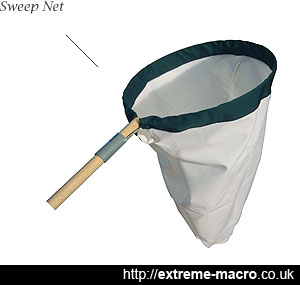Catch Insects Using A Sweep Net
by Johan J Ingles-Le Nobel
Last updated August 31, 2017
A sweep net is a funnel-shaped net attached to a long-handled frame that is swept back and forth through the tops of grasses, grains and ground foliage with a clear top, and is commonly used in agriculture to count for pests and to justify the case for pest spraying; some of the common pest insects that can be captured in sweep nets include weevils, plant bugs, leafhoppers & stink bugs.
Sweep nets have been used for collecting by entomologists since Victorian days and is one of the easiest ways to catch insects for studio photography of insects as they generally tend to catch the adult stage of the insect.
Sweep Net Catches

Sweep Net for collecting macro specimens to stack in the studio. Expect to pay about £50 for a decent one.
Depending on the habitat/field that you are sweeping, weevils, plant bugs, leafhoppers, beetles, spiders, wood wasps and snails are all commonly caught in a sweep net. You get great results with a sweepnet going through short vegetation such as grass, nettles and reeds. Rough grassland is especially effective and for meadow insects, a sweep net is a must.
The Classic Sweep Net
Sweep net bags are made of cotton muslin (similar to a bedsheet) or sailcloth, a tougher cotton-canvas material. Muslin, which is lighter in weight and dries faster than sailcloth, is a good choice for sweeping soft, non-brushy plants such as small grains and many vegetable crops but beware if the area that you're sweeping contains strong sturdy stalks with spikes or thorns.
Alternatively, you can always just try making your own with a wire hanger as the hoop, a broomstick, duct tape and a pillowcase.
How to Sweep
- Hold the net with the hoop end nearest to the ground in front of you. The plane of the hoop should be perpendicular to you.
- Swing the net from side to side in a full 180 degree arc. Sweep one stroke per step as you casually walk through the field or down the row. The more rows you do the more you catch.
- Tilt the net opening so the lower edge of the rim is slightly ahead of the upper rim.
- In short vegetation, swing the net as deeply as possible.
- In taller vegetation, sweep only deeply enough to keep the upper edge of the sweep net opening even with the top of the plants.
- In general, don't let the net go too far below the top of the plants, ie 15 cm.
- At the end of the sweep, turn the net with its opening down and horizontal. The bottom of the net will drape over the edge of the frame and will trap any insects that have been caught
- Sweeping does not generally catch insects that live close to the soil surface and you will miss many of the larger, faster species which, alerted by your vigorous progress through their habitat, will escape before you get to them. Even so you will be amazed at how much can be collected even from unpromising-looking sites.
- A sweep net can also be used to collect insects in a rough manner from trees and shrubs.
- There is no particular time of the day that is recommended for sweeping. Some insects perch at night and sweeping first thing in the morning will get these for you, but other insects are out and perch during the day.
- If you develop a standardized sweep technique, then it's worth keeping some notes of the quantities caught - to be able to return to the richest grounds in the future.
When Not To Sweep
Rain and sweeping for insects really don't go well together. Once your sweepnet becomes damp, the specimens that you'll collect will stick to the side and the leaves mushy, no good for photography whatsoever. Avoid sweeping if it's been raining during the day or early in the morning when it's still damp.
What To Look For
Rain and sweeping for insects really don't go well togetherAs you use the leading edge of the hoop to hit the vegetation, a sweep net that has some strengthening around this leading edge is nice to have. The larger the rim diameter, the more insects you will collect, so larger is generally better. Sweep nets can and do wear out because there's been a lot of sweeping with them. Collapsible sweep nets are nice too. I keep mine collapsed in the boot of the car, nicely out the way but ready whenever I need it.Depth of net matters. You want a nice deep net otherwise insects escape easily. I bought my sweep nets from Watkins & Doncaster, and they're pretty good.
How To Empty The Sweep Net
Generally, place the opening of the net over your head and with one hand extend the net bag horizontally outwards, or very slightly upwards, in the direction of the sun. Most of the insects will be attracted towards the more brightly lit end and will also tend to move upwards, ie towards the closed end of the net. Do not empty the net by looking down into it since most of the insects will escape. This method can be quite uncomfortable, especially in hot, humid conditions but has the advantage that insects can be collected alive (if required) and that it is not necessary to carry any other piece of equipment whilst collecting.
Related Articles





